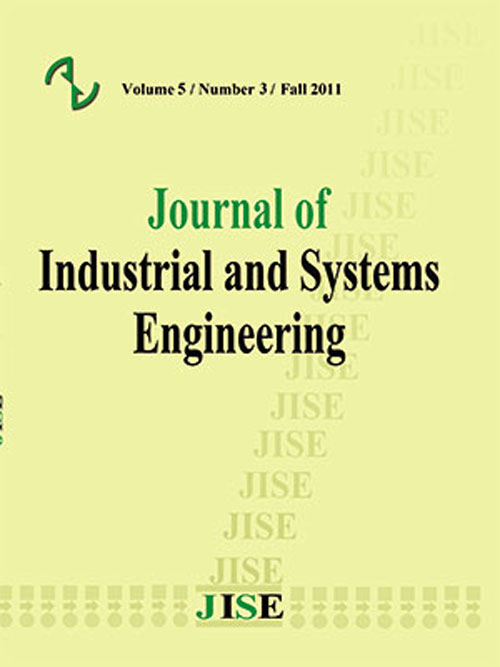فهرست مطالب
Journal of Industrial and Systems Engineering
Volume:3 Issue: 3, Autumn 2009
- تاریخ انتشار: 1388/08/12
- تعداد عناوین: 4
-
-
Pages 152-169Managing operations of the aircraft approach process and analyzing runway landing capacity,utilization and related risks require detailed insight into the stochastic characteristics of the process. These characteristics can be represented by probability distributions. The focus of this study is analyzing landings on a runway operating independent of other runways making it as a single runway. We provide statistical analysis of the final approach and runway occupancy time at Detroit airport at peak traffic periods on one of its major landing runways. Many weeks of aircraft track record data collected by a multilateration surveillance system is analyzed. We explain some characteristics and short comings of the database, and extract samples of the random variables of interest (i.e. aircraft time and distance separation, runway occupancy time, simultaneous runway occupancy, and aircraft speed). We estimate probability distributions of these variables under both instrument and visual flight rules. Although the focus here is on one runway at a large airport, probability distributions of these random variables for the landings on similar single or independent runways (with similar physical design, operating systems and landing guidance instruments) shall be alike.Keywords: Runway landing, Final approach, Aircraft separation, Landing systems, Multilateration data, Distribution fitting, Risk
-
Pages 170-188The classical economic production quantity (EPQ) model is a well-known and commonly used inventory control technique. Common assumptions in this model are that all units produced are of perfect quality and shortage is not allowed, since in practice shortage, non-conforming product or scrap items are possible, these assumptions will underestimate the actual required quantity. The objective of this paper is to provide a framework to integrate production of imperfect quality items, inspection errors, rework, scrap items and backlogging into a single EPQ model. To achieve this objective a suitable mathematical model is developed and the optimal production lot size which minimizes the total cost is derived. The sensitivity analysis results indicate the model is very sensitive to shortage cost per unit shortage and type-I error of inspection. While findings of this study show that the model is very sensitive to parameters type-I error of inspection, proportion of defectives in production process and shortage cost per unit short, it is much less sensitive to parameters like proportion of scraps in rework process andType-II error of inspection. If the existence of such error and shortages are ignored, then the obtained results may differ considerably from the optimal outcome. This will impose additional costs to the system.Keywords: EPQ, Rework, Inspection errors, backlogging, Scraps
-
Integrated Procurement, Production and Delivery Scheduling in a Generalized three Stage Supply ChainPages 189-212In this research, we investigate a three-stage supply chain with one supplier, several manufacturers and multiple retailers where the supplier provides a common raw material to each manufacturer, who in turn uses a single stage production facility to convert it into final products that are delivered at fixed lot sizes to retailers. An integrated economic procurement, production, and delivery model is developed whose objective is to find the common production cycle length, production sequences of final products at manufacturers and delivery frequencies of final products to retailers minimizing the total costs of considered supply chain. We propose an analytical solution procedure and an efficient heuristic solution method. The proposed heuristic solution algorithm is able to find the optimal solutions for the small and medium problem instances and consequently it is very promising for solving the large-sized instances in a reasonable time.Keywords: Logistics, Supply chain management, Inventory, Integrated decision making
-
Pages 213-226In this paper, three dynamic pricing models are developed and analyzed. We assume a limited number of a particular asset is offered for sale over a period of time. This asset is perishable and can be an inventory or a manufacturing capacity. During each period, the seller sets a price for this asset. This price is selected from a predetermined discrete set. The maximum amount which a customer is willing to pay is called "reservation price". Different customers have different reservation prices. The distribution function of the reservation prices for all potential customers is known. Demands arrive according to a nonhomogeneous Poisson process. To maximize the expected revenue, the price of this asset is controlled periodically, as sales evolve. Demand cancellation is also considered. Furthermore, we study the effect of cancellation as well as setting a sale limit for each period. The analysis of the models indicates that their properties are different from those of the basic models studied previously. By randomly generated examples, we show that the properties of “Inventory Monotonocity” and “Time Monotonocity” do not hold in our models, while these properties hold for continuous price review models.Keywords: Dynamic pricing, Periodic review, Cancellation, Dynamic programming


